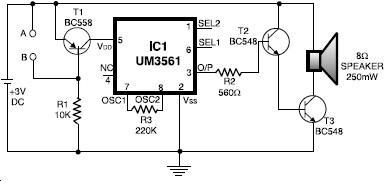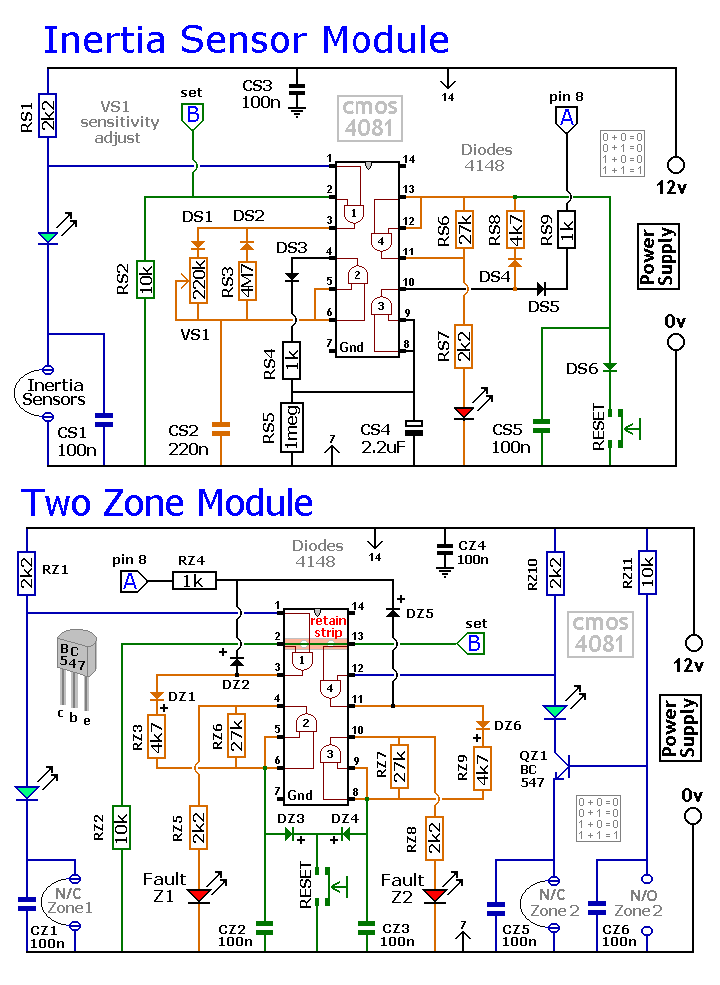
Frost Alarm

The thermistor used has a resistance of 15k at 25 degrees and 45k at 0 degrees Celsius. A suitable bead type thermistor can be found in the Maplin catalogue. The 100k pot allows this circuit to trigger over a wide range of temperatures. If using a different thermistor then the control should match the new thermistor at its highest resistance, or be higher in value. The op-amp in this circuit is the ubiquitous 741.
The described circuit utilizes a thermistor with specific temperature-resistance characteristics, notably 15kΩ at 25°C and 45kΩ at 0°C. This thermistor can be classified as a negative temperature coefficient (NTC) thermistor, meaning its resistance decreases with an increase in temperature. The selection of a bead type thermistor from the Maplin catalogue indicates a preference for compact and reliable components suitable for various applications.
The circuit employs a 100kΩ potentiometer (pot), which provides adjustable resistance to accommodate a wide range of temperature sensing applications. The ability to modify the resistance allows for fine-tuning of the circuit's response, ensuring that it can effectively trigger at various temperature thresholds. When substituting a different thermistor, it is critical to ensure that the potentiometer's maximum resistance is at least equal to or greater than the highest resistance value of the new thermistor. This ensures compatibility and maintains the circuit's functionality across the desired temperature range.
An operational amplifier (op-amp) is included in the circuit design, specifically the widely used LM741. This op-amp is known for its versatility in various applications, including amplification, filtering, and signal conditioning. In this configuration, the op-amp is likely used to amplify the voltage signal derived from the thermistor, allowing for more precise temperature readings and control. The circuit may be configured in a non-inverting or inverting arrangement, depending on the intended application, such as temperature monitoring or control in a feedback loop.
The overall design emphasizes the importance of component selection and configuration in achieving reliable temperature sensing and control. Proper calibration and adjustment of the potentiometer, along with the correct thermistor choice, will ensure optimal performance of the circuit across the specified temperature range.The thermistor used has a resistance of 15k at 25 degrees and 45k at 0 degrees Celsius. A suitable bead type thermistor can be found in the Maplin catalogue. The 100k pot allows this circuit to trigger over a wide range of temperatures. If using a different thermistor then the control should match the new thermistor at its highest resistance, or be higher in value. The op-amp in this circuit is the ubiquitous 741. 🔗 External reference
The described circuit utilizes a thermistor with specific temperature-resistance characteristics, notably 15kΩ at 25°C and 45kΩ at 0°C. This thermistor can be classified as a negative temperature coefficient (NTC) thermistor, meaning its resistance decreases with an increase in temperature. The selection of a bead type thermistor from the Maplin catalogue indicates a preference for compact and reliable components suitable for various applications.
The circuit employs a 100kΩ potentiometer (pot), which provides adjustable resistance to accommodate a wide range of temperature sensing applications. The ability to modify the resistance allows for fine-tuning of the circuit's response, ensuring that it can effectively trigger at various temperature thresholds. When substituting a different thermistor, it is critical to ensure that the potentiometer's maximum resistance is at least equal to or greater than the highest resistance value of the new thermistor. This ensures compatibility and maintains the circuit's functionality across the desired temperature range.
An operational amplifier (op-amp) is included in the circuit design, specifically the widely used LM741. This op-amp is known for its versatility in various applications, including amplification, filtering, and signal conditioning. In this configuration, the op-amp is likely used to amplify the voltage signal derived from the thermistor, allowing for more precise temperature readings and control. The circuit may be configured in a non-inverting or inverting arrangement, depending on the intended application, such as temperature monitoring or control in a feedback loop.
The overall design emphasizes the importance of component selection and configuration in achieving reliable temperature sensing and control. Proper calibration and adjustment of the potentiometer, along with the correct thermistor choice, will ensure optimal performance of the circuit across the specified temperature range.The thermistor used has a resistance of 15k at 25 degrees and 45k at 0 degrees Celsius. A suitable bead type thermistor can be found in the Maplin catalogue. The 100k pot allows this circuit to trigger over a wide range of temperatures. If using a different thermistor then the control should match the new thermistor at its highest resistance, or be higher in value. The op-amp in this circuit is the ubiquitous 741. 🔗 External reference





